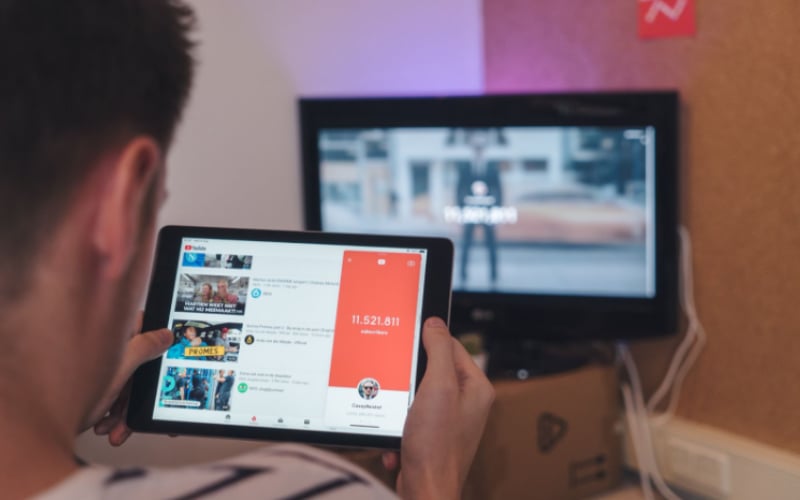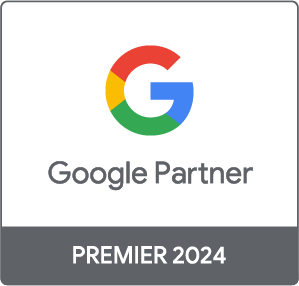Google ad types - how to choose the right ones?

Google Ads deliver, on average, an 8:1 return on investment, according to Google. There are, of course, many factors influencing that but the point is, you could be missing out on sales if you’re not using the right type of paid search campaigns and ads.
If you’re struggling to figure out what to use for your business, this guide helps simplify it all. Defining goals, explaining the Google campaign and ad types, and how to choose the right ones for your business.
When you factor in the many different Google PPC campaign types and ad formats, it’s hard not to be overwhelmed. Especially if you’re short on time. Knowing where to invest your efforts is half the battle.
Here’s our whistle-stop tour of paid search, distilling what we’ve learned from years of working on Google Ads for multiple clients. Big, small, and everything in between.
Defining PPC campaign goals
You need to identify your goals first. Otherwise, it’s like setting off in the car, and not knowing where you’re heading. Ultimately you're going to get lost. Being clear on your goals will help you to choose the right paid campaign and ad type.
Sounds easy but there are layers to this. Campaign goals can include easily measurable elements like sales, leads, and web traffic. They can also include less easy-to-attribute goals like brand awareness, product/brand consideration, and app promotion. We’ll get into attribution in PPC another time.
How do you know what paid search campaign goals to set?
Setting sales, leads, and traffic as targets is most widely used for products that the target audience is already familiar with - LEGO for example. Whereas brand awareness would be more suitable to reach new audiences or in emerging markets for new products and services.
You can measure one or multiple metrics. That’s the beauty of PPC - the amount of data you have at your fingertips. But be wary of getting distracted from your main goal by trying to do it all.

How to choose the best Google Ads campaign
Once you’ve defined your goal, you can start to look at the different campaign types. Some are more suited to achieving certain objectives than others. Google PPC campaign types include Search Network, Display Network, Shopping, video, app, smart, local, Performance Max, Discovery, and call campaigns.
For example, a B2C ecommerce company might look at running a Shopping campaign to generate sales directly from the ad. Whereas a fitness provider might run a Google Display Network campaign to promote their latest workout video and drive leads to sign up for their service.
Let’s look at each Google Ads campaign type in more detail:
Search Network campaigns
- Where: The Search Network is a group of search-related websites where ads and product listings appear. Ads are placed on Google search results pages, including Maps, Shopping, Google Images, as well as other Google partners.
- When to use: These campaigns are suited to driving traffic when potential customers are actively searching for related products or services. These customers know what they want, so you serve them an ad that meets that need.
- Ad types: Responsive search ads and call ads.
Display Network campaigns
- Where: The Display Network (also known as GDN) contains over 2 million websites, videos, and apps, including Google-owned properties like YouTube and Gmail. Ads placed on this network have the opportunity to reach a huge audience.
- When to use: Display campaigns are particularly effective for increasing brand awareness and generating leads from new audiences. There are targeting options so you can be strategic about where you appear and to whom. That can be in multiple places, reinforcing your message. This process of finding the right audiences can also be automated to help increase conversions.
- Ad types: Image and responsive ads.
- Read more about ads on Google Display Network
Shopping campaigns
- Where: Shopping campaigns appear in the Google Shopping results. The ads have a specific more visual format.
- When to use: Shopping campaigns are suited to businesses that sell physical products. They can be used to drive sales but also boost traffic to your site or store. They’re a good way to pre-qualify leads because they’ve already seen more about your product than a simple text ad for example.
- Ad types: Shopping ads
Video campaigns
- Where: Video campaigns appear on YouTube and other Google-owned video sites.
- When to use: Video campaigns have targeting and bidding options to help you appear to the right audience. You can set specific goals - sales, leads, site traffic, brand awareness, and consideration. Combined with the visual and engaging nature of the medium, this makes them work particularly well for increasing awareness and consideration.
- Ad types: Skippable and non-skippable in-stream ads, in-feed video ads, bumper ads, out-stream ads, masthead ads
- Read more about Videos ads
App campaigns
- Where: App campaigns work slightly differently from the other campaign types. You don't need to design specific ads, Google will use the ad text, images, videos, and any other assets from your app store listing. It then generates ads to serve across the networks. Based on machine-learning it determines your highest-performing ads and their placement.
- When to use: App campaigns are aimed at increasing downloads or in-app engagement.
Local campaigns
- Where: Local campaigns make it easier for you to promote your local presence across Google’s advertising channels - like the Search Network, Maps, Display Network, YouTube, and Gmail.
- When to use: Local campaigns are designed to get customers to your physical location. Location data is used to trigger ads based on intent - like local query and map searches - and your proximity to the location. In theory, if you’re looking for a pet food shop in Bristol you won’t see an ad for one in York.
- Ad types: Local search ads
- Read more about Local ads
Discovery campaigns
- Where: Discovery campaigns are available on Discover, YouTube Home and Watch Next feeds, and the Gmail Promotions and Social tabs. They have a reach of up to 3 billion users, meaning you can appear to a huge audience with one single campaign.
- When to use: Discover campaigns are ideal for driving conversions at scale, reaching new audiences, and reconnecting with customers to drive repeat business. You provide assets like headlines, images, and logos, and then Google displays these to the audiences you’ve defined and budgets you’ve set.
- Ad types: Image ads
- Read more about Discovery ads
Performance Max campaigns
- Where: Performance Max campaigns give you access to Google’s range of channels, including Search, Display, Discover, Maps, YouTube, and Gmail.
- When to use: Performance Max is a new campaign type, replacing Smart Shopping campaigns. These campaigns are good if you’re not limited by channels.
- Ad types: Performance Max focuses on overall goals rather than per channel. They include all your ad types within a single campaign (rather than separate ones). The goals you set are then used by automated bidding technology to help you increase conversions across these channels, rather than in isolation.
- Read more about Performance Max campaigns
Call campaigns
- Where: Call campaigns can be used across the Search Network.
- When to use: If your primary objective is getting calls to your business directly from your ads, you can use call campaigns. They work much like search campaigns but with the action being to call rather than click to visit a landing page.
- Ad type: Call ads

What Google ad types are there?
In addition to the various campaign types, there are also different ad formats that you can choose from. These include text ads, image ads, video ads, and call ads.
What’s the difference between paid search campaigns and ads?
Essentially campaigns sit above ads. They set the overarching structure, goals, and budget. The type of PPC campaign will determine where your ads appear and the type of ads you can use. Ads are housed within the campaigns and are what users will see.
Some pairings of campaigns and ad types are obvious, for example, video ads are used in video campaigns. Meanwhile, Performance Max campaigns contain ‘asset groups’ and ‘assets’ which are made up of multiple headlines, descriptions, images, and videos to create adverts that Google choose using their AI to deliver the right ad at the right time and to the right person. Each ad format has its own unique benefits and can be used to achieve different goals.
Text ads
Text ads appear above and below the search results on the Google Search Network. They are made up of a URL, headlines, and descriptions. For these ads to appear on the results pages, they need to meet the requirements set out by Google. These have now been replaced by Responsive Search ads (there were also Expanded Text ads but those were sunsetted in June 2022).
Responsive search ads
Responsive search ads are essentially a more sophisticated version of the original text ads. Instead of creating a static ad with one headline and description, you can write up to 15 headlines and 4 descriptions. Yes, that’s a mind-blowing 40,000+ combinations to test out. Google’s machine learning will serve up what it finds out to be the most relevant based on the search query. It’s made learning much faster.
Image ads
Image ads are just that - they’re a graphic - be that static, animated, or a GIF. They appear across the Display Network in a range of sizes and placements. The key to success is to stand out visually. To save you from needing to create multiple versions, responsive display ads automatically adjust to the size the ad needs to be across different devices and the available ad space. Clever.
Video ads
Image ads are just that - they’re a graphic - be that static, animated, or a GIF. They appear across the Display Network in a range of sizes and placements. The key to success is to stand out visually. To save you from needing to create multiple versions, responsive display ads automatically adjust to the size the ad needs to be across different devices and the available ad space. Clever.
Video ads
- Skippable in-stream ads
- Non-skippable in-stream ads
- In-feed video ads
- Bumper ads
- Outstream ads
- Masthead ads
There’s not enough time to go into them all here but all of them must be hosted on YouTube and will appear here and on other Google video partner sites (caveat: this depends on the format and campaign settings).
- Read more about Videos ads

Shopping ads
Shopping ads give a snapshot of the product - an image, title, description, and price. Your Merchant Centre uses your existing product data to create the ads and work out where to show them depending on the audience you want to target. They don’t use keywords to determine relevancy, so the information in the ad needs to incorporate relevant terms to appear for related queries. These are called Product Shopping ads. Local inventory is then created using the product information and inventory data that you enter into your Merchant Centre.
Call ads
Call ads are click-to-call rather than click-to-visit a landing page. They only appear on devices that make phone calls. You can also set your ads to only appear when you’re open so you don’t waste your budget.
In summary, to achieve the best possible results from your paid search campaigns, start by defining your goals - lead generation, driving traffic, getting sales, and building brand awareness or consideration.
Once you’ve mapped that out (it isn’t necessarily one or the other and it can change over time) then you can start to think about the right campaign type and ad format. Then the most valuable part begins when you’ll need to test, test, test to get the content and design right to increase conversions.
- Find out more about our paid search services








